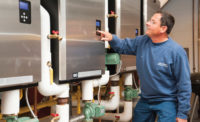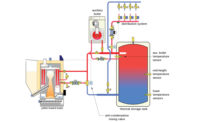A friend of mine once jokingly referred to me as the Doctor of Hydronic Misbehavior. Well, I’ve recently had some issues with low-mass systems, which have just about sent me to the counselor’s couch, but rather than surrendering to the stress, I elected to find a solution.
And though Harvard and Yale haven’t mailed my doctoral degree yet, I thought I’d share some of this with you. Please, make yourself comfortable on my couch as I relate this tale of woe.
You see, in my many years of interacting with finicky low-mass boilers — as much a fan as I’ve become of the super-efficient, high-tech systems — I’ve also seen routinely how the low-volume start-and-stop operations, and the maintenance required to keep them operational, may not be the best long-term economics for boiler owners.
For home and business owners with these systems, there’s a hefty maintenance price to pay. And, some of these systems are also prone to problems with heat exchangers that occasionally (not rarely) lead to replacements. Many have life expectancies of just six to 10 years, something that’s really hard for homeowners to swallow. This is surely a big, unpleasant surprise for those who aren’t aware of or prepared for it. Part of the problem, for sure, is the declining quality of water, nationwide.
Typically, untreated water can be a recipe for disaster (Anthony Tosco’s last column dealt with that, and he was spot on). Of course, if water treatment is an ongoing issue, a treatment system will be needed, and that can lead to hefty expenses, too.
MOD-CON WITH HIGH-TEMP RADS?
One of the key mistakes we’re seeing nationwide is the mismatching of low-mass, modulating-condensing (mod-con) systems with high-temp baseboard radiation. Sorry to say, but in my opinion — which has been confirmed by many smart folks in this industry and multiple home and business owners, too — they aren’t compatible. We get a lot of calls and emails from throughout the U.S. and Canada from our website confirming this. And, plenty of experts agree, too.
And that’s led to a lot of service work for us as we attempt to repair systems that may need more than the occasional doctoring. Sure, we like service work, but in all fairness to home and business owners, this issue should be remedied or, better yet, avoided from the start.
Many people are romanced by the idea of a small boiler that gently sips fuel with its pinky finger extended. An installer, perhaps (hopefully) with good intentions, assures them that having a mod-con boiler is a great way to save on fuel costs. But, the reality is, these systems are designed to work optimally as a heat source for low- and medium-temp radiation.
BACK TO THE FUTURE
Our company has modified its approach to building optimal hydronic systems. We’ve now changed “the spec” to designing high-mass mod-con boilers (Viessmann Vitocrossal CU-3 and CM-2 for commercial jobs). We set them for long run times and negligible heat loss within the boiler. We also couple them with low-temp delivery systems, such as radiant heat or substantially sized panel radiators.
It’s a bit like going full circle back to what we did with high-volume oil boilers many years ago.
The results have been very good. We’re seeing less operational breakdowns and higher operational efficiencies.
As we design and install these systems, we’ve also seen to the importance of making sure the pumping strategy fits. The boilers we use require no primary secondary piping, low-loss header, or buffer tanks, which allows for less installation and operational costs in moving fluid. Most systems we install are equipped with Taco’s growing family of electronically commutated motor (ECM) circulators and Zone Sentry zone valves. We appreciate the reliability and efficiency they offer.
As an owner of a company that installs both hydronic and forced-air systems, I typically steer customers toward hydronics when they talk about the need for comfort and efficiency. There’s really no comparison when the two are put side by side. Sure, forced-air systems get the job done, but often at the cost of comfort — to some degree, based on the application.
Want tile or stone floors with comfort all winter long? Or, if homeowners are getting older and have experienced the discomfort of chilled legs and feet, the recipe’s already there.
REFINING THE APPROACH
I like trying to find the lowest curve possible when developing a system so boilers run at the lowest possible temperature and also so that pumps run almost non-stop during heating season. After all, wasn’t it the famous hydronic psychotherapist Sigmund Freud who advised many years ago that constant circulation provides the greatest comfort?
If the Freud reference threw you for a loop — OK, I thought it might — let’s bring this back to reality and in for the close.
The industry tends to only look at combustion AFUE but the fact is system efficiency is a much more important factor in overall operational economics. Consumers (and plenty of trade pros, too) tend to get enamored with a single unit’s efficiency. If a boiler’s promoted at 97 percent efficiency, that’s probably its real efficiency — in the lab and under just-about-perfect conditions.
Will your homeowner’s home match that? Um, probably not.
In my humble opinion, large volume, low curve promotes high standby efficiency and offers a sustainable future for your heating system.
Sustainable systems promote long-term relationships with your customers along with great economics, too.
That makes my business sustainable.
Publication date: 9/5/2016
Want more HVAC industry news and information? Join The NEWS on Facebook, Twitter, and LinkedIn today!








